(1926-2023)

Malvina Schmacher Scott Biography—Click here for pdf file

Catholic: Kelly/Kelley, Michael Kelly baptism & Kelly/Kelleys after immigration ; Bressette & Schumacher.
Anglican (including Church of Ireland): Michael Kelly and his daughter’s confirmations before immigration; and the English, prior to immigration.
Episcopalian: Early Virginians on mom’s side; English ancestry.
Religious Society of Friends Church (Quaker) Mary Irwin Clifford, late in life.
Methodist: Dean Kelley, Cornett? & Russell, Scott.
Lutheran: Reimers, DeBuhr, Hefner, Hechler, Baugher, Weimer prior to immigration; German ancestry.
Mennonite: Schantz, Weimer, Delp; all German ancestry.
Dunkard: Hildebrand, German ancestry.
Evangelical (Dutch or German) Reformed Church Auen, Likely Deckers & Verbrycks, Delp prior to immigration; includes Frisian.
Presbyterian: Auen, Irwin, likely Gordon & Lawson; Frisian and Scotch-Irish
Baptist: Doretta in High School, Sarah Verbryck Clifford bible
General non-denominational Christian: Doretta as a child
The history of religions in my family appears to mirror much of what occurred In America’s melting pot. Some ancestors may have been part of the original founding colonies, but most were people who assimilated into the populations where they migrated. People of different religions met and married. Ancestral couples would then have to decide which traditions to adopt and pass on to their children.
Dana Kelley Bressette (me). I have been mostly unchurched. I vaguely remember attending church/Sunday School as a small child. I sometimes went to my best friend’s Evangelical Free Church after spending the night at her house. Most of my religious education came through watching movies, the Ten Commandments, and the like. My brother, Bruce, joined the Old Apostolic Lutheran after returning home from College.
Kelleys:

My great-great grandfather, Michael Britt Kelly, was baptized in the Catholic Church, but at some time prior to his marriage he converted to the Church of Ireland (Anglican). We know from history that there was strong economic pressure in Ireland which forced many to convert just to be able to work and live a decent life in Ireland. Michael Kelly was a teacher and even taught school at a parochial Church of Ireland school in Beigh-Askeaton, Limerick County, during the famine years. His children were baptized and confirmed in the Church of Ireland. After immigration to the U.S. It is unclear whether Michael converted back to Catholicism, but his children were all married and had children baptized at St. Mary’s Catholic Church in Clinton, Iowa.
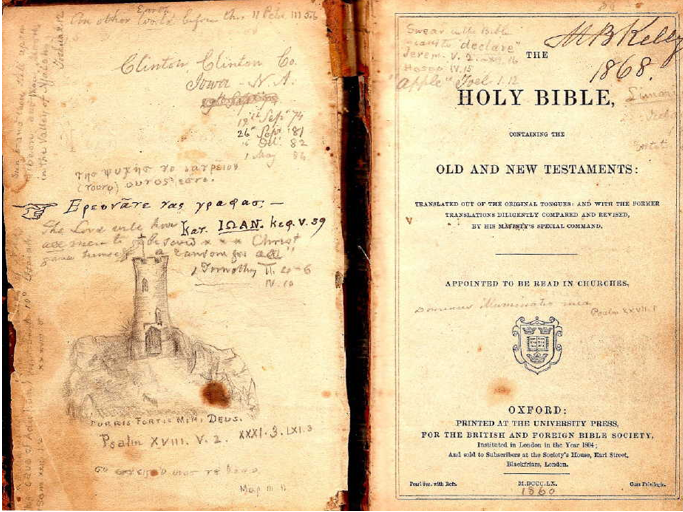

My great-grandfather, Andrew Alfred Kelley, was baptized in the Church of Ireland. He married his first 2 wives at St. Mary’s Catholic Church in Clinton, Iowa. He later moved to western Iowa where he met and married my great grandmother, Ida Auen. She was the daughter of East Frisian immigrants who attended a Presbyterian Church in Breda, Iowa. They were married in Carroll at the County Courthouse. They settled in Arcadia, Iowa, where St. John’s Catholic Church loomed large.

My Grandfather, William Walter Kelley, was likely raised Catholic in the small town of Arcadia, Iowa, but probably attended his mother’s Presbyterian Church at times. According to a family story, the family was working in the garden when the church bells rang out. Bill complained about having to go to Mass for some long dead person. His father, who overheard, pitched an ear of corn that went whizzing by Bill’s ear. Bill left home, at age 15, (and the Catholic church) the next day and joined a travelling medicine show. He settled in Holstein, Iowa where he met his wife, Marie Reimers. They were married at the Carroll County Courthouse. As a child, his oldest son, Warren went to the Lutheran church with his Grandmother Reimers and continued to attend after her death. But when he was told he had to be baptized to continue to attend, His father, Bill, got mad and refused to allow it. Afterwards Warren went to the Methodist Church. (Bill was active in the Masons, John J Mercer Lodge in Omaha.)
My father, Dean Darrell Kelley, Dean Kelley- was baptized, when he was 16, in the Methodist Church in Omaha Nebraska. He married my mom, Doretta Clifford at a Methodist Church in Monterey Park, California. He did not attend church regularly. Later in life when asked, he would just say that “When you have taken as many philosophy courses as I have, you begin to question.”
Auens:
Eilert and Jantje Auen emigrated from East Friesland in Germany.

According to records from my cousin, Sharon Knoblock, Eilert was christened in the Evangelical Reformed Church in Beschotenweg. Ostfriesland. Jantje attended the Evangelical Lutheran Church in Warsingsfehn, Ostfriesland, where Eilert and Jantje were married. It is unclear whether their specific ancestors were Lutherans or Reformed. In the description of the record collection “Germany, Lutheran Baptisms, Marriages, and Burials, 1500-1971”at Ancestry, it states that “Events in the original church registers were recorded by the local pastor. Occasionally, events recorded in the lives of Lutheran, Reformed and Catholic parishioners were combined together into a single register.” Eilert and Jantje Auen settled in Wheatland Township in Iowa where they attended the Wheatland Presbyterian Church in Breda, Iowa. (Presbyterians arose out of Calvinist (Reformed) Churches.)
Reimers:

Claus Johann Reimers and Marie Brocksen emigrated from Schleswig-Holstein in Germany. They were both baptized in the Evangelical Lutheran Church. As were their ancestors many generations back.
Brocksen/Brockes:
My 6th great grandfather, Barthold Heinrich Brockes (1680-1747), a German poet,born in Hamburg, is my most famous confirmed ancestor. In his Passion oratorio: “Der für die Sünde der Welt gemarterte und sterbende Jesus“ (Jesus Who Suffered and Died for the Sins of the World), a tenor Evangelist narrates events from all four Gospels’ accounts of Jesus’ suffering and death. It was set to music by composers such as Handel, Telemann and others. He was best known for his poems extolling the glory of god and the beauty of the natural world. In his book of poems: Irdisches Vergnügen in Gott (Earthly pleasure in God), he wrote poems about the world, the seasons, the elements, time, the weather, the landscape, animals, trees & flowers, the human condition, and more… Following is a poem he wrote extolling God: (The translation is directly from Google Translate, with a few small changes. I am surprised at how well it came out!)

Cliffords:
My mom’s family were not regular church goers. However, my mom, Doretta Clifford-earned a bible school promotion from the First Christian Bible Church in June 1939, when she was 8 years old. In High School, she became a member of the Alhambra Baptist Church (mostly for social reasons).
I don’t know of any particular denomination that my grandparents, Walter Clifford & Alice Cornett, attended, but it is likely they attended local churches in Kansas where they grew up. Alice was familiar with hymns sung at her grandson’s church. Walter and Alice were married 1st at the County Courthouse in Bartlesville, Oklahoma, 2nd in Orange County California.
My great grandparents, Charles Clifford and Sarah J. Verbryck were married by a Probate Judge in Independence, Kansas.

Charles Clifford’s mother, Mary Irwin: From her obituary: “She was once a member of the Christian Church but united with the Friends in 1895.” (Age 74) The Society of Friends are the Quakers.

Although the Cliffords were thought to be English. Many on this line were Scotch-Irish or Manx (The Gordons, Lawsons, & Irwins.) It is a good guess that the Scotch-Irish would have been Presbyterian.
The exception on this side is the Deckers.
Although, Dorcas Decker Irwin, my 3rd Great-Grandmother was baptized at the St. John’s Episcopal Church in York, Pennsylvania. She mostly descends from Dutch settlers in New Netherlands (New York), even though her paternal Decker line may have originated in Schleswig-Holstein and Denmark. It is likely that most of her ancestors in this country were members of the U.S. Dutch Reformed Church.
Verbrycks:
The Verbrycks also mostly descend from Dutch Settlers in New Netherlands, although some may have been from other areas such as Belgium, France, Germany, Schleswig-Holstein, East Friesland, Spain, Norway, & England. My 4th great-grandparents, William Verbryck and Rebecca Low, were members on the U.S. Dutch Reformed Church in New Jersey.

Holts: My 3rd great grandfather,William Verbryck Jr. married Sarah Holt in Mercer County, Kentucky. Her parents were reportedly born in Virginia and North Carolina. I have tried to use DNA to figure out this line but have been unable to verify her lineage for sure. My best guess is descendancy from the family of Plunkett Holts (Jr and/or Sr.) due to shared matches with a known Holt DNA match. Most in those lines appear to have been Baptists, with some Methodists.
Hildebrand: Abraham Hildebrand, my 4th great-grandfather, chose to be non-associated during the Revolutionary War due to his religious beliefs as a Dunkard – a Peace church. He married Anna Schantz whose family were active in the Mennonite Church. “The Mennonites like the Brethren, at the time, used lay ministers who were elected by the Congregation. The State of Pennsylvania did not recognize marriages performed by Lay ministers. Abraham and Anna were married February 14, 1776, In Saint James Episcopal Church of Lancaster… to have a lawful marriage approved by the state.”
Weimer: My 5th great-grandfather, John Dewatt Weimer and family were listed as members of the Mennonite church in Lancaster, Pennsylvania. The family was likely Lutheran prior to emigrating from Dortmund, Germany.
Hefner: My 5th great grandfather, Albertus Hefner and his wife were buried in a Lutheran Cemetery in Franklin County, Pennsylvania.
Cornetts: I have no direct evidence on the religion of the Cornetts, but looking at where they came from in Grayson County, Virginia, it is likely that they were Methodists or perhaps, Baptists.
Russell: Philip and Rebeckah Russell, my 4th great-grandparents, were married by the Reverend Elisha Bedwell, a Methodist minister in Grayson County, Virginia. The Russells, originally were from Kent in England and were likely Anglican.
Stamper: Jonathan Brooks Stamper, my 6th great-grandfather, was baptized in Christ (Episcopal) Church Middlesex County, Virginia. His parents, Powell Stamper and Mary Brooks were also married there.
Hackler/Hechler: Peter Hackler/Hechler, my 4th great grandfather, was baptized inQuickel’s (Zion) Lutheran and Reformed Church, York, County Pennsylvania.
Delp: Hans George Delp, my 6th great grandfather,was baptized in the Evangelical Reformed Church in Darmstadt, Germany. He apparently, joined the Mennonite Church when he married in Pennsylvania.

Woodrum: John Woodrum, my 6th great grandfather married his wife Mary/Molly at St. James Northam Parish Episcopal Church in Goochland, Virginia, about 1727. It is likely that most of the early Virginians on this side of the family were Episcopalian.
Baugher: Emily Jane Baugher, my 2nd great grandmother: It states in her obituary: “She was a Christian from early womanhood and a faithful servant the Christ she promised to serve.” Her funeral was officiated by a Methodist Episcopal minister. John Jacob Baugher, my 5th great-grandfather was christened at St. Matthews Lutheran Church Hanover, Adams Co., PA. His father Pastor Johannus Georgius Bager was sent to America by the Lutheran Church and is credited with establishing over 100 Lutheran churches in Pennsylvania and Maryland.
Higginbotham: I have not been able to confirm a lineage for this side of the family. There are a few different trees that show different possible ancestries. But it is clear that we must descend from Captain John Joseph Higginbotham (1638-1813) (or at least a relative). He was born in Saint Philip Barbados and died in Amherst, Virginia. We have many DNA matches to Higginbothams who descend from this family. He was baptized at Saint Philip Parish (Anglican) Church.
My husband, Edmund Bressette’s family:
Edmund Bressette, Jr. was raised Catholic.

His father, Edmund Bressette, Sr.’s ancestry is all Catholic French Canadian as far as I have been able to determine. He attended Keveny Memorial Academy, a Catholic School in Cohoes, New York.
Scott: Ed Jr’s mother, Pamela Scott, was also raised Catholic and attended Aquinas Academy, a Catholic girls High School in Tacoma, Washington. Her mother, Malvina Schumacher Scott, descends from ethnic Alsatian/Germans, who had immigrated to “Little Russia” in the Odessa region of the Ukraine, prior to immigrating to the Dakota Territory in the U.S. (Most of these Russian-German immigrants were Lutheran, some were Mennonite, about ¼ were Catholic. The Alsatians may have been predominantly Catholic.) I don’t know if all Malvina’s ancestors were all Catholic or not.
Malvina and Oren Scott were married by Rev. James J. Buck, a Catholic Priest in the rectory at the Star of the Sea Catholic Church.
Pam’s father, Oren Scott, was adopted by Russell and Erma Scott, who were married by Bert V. Bradshaw, Russell’s brother-in-law, a Methodist Minister.
On Oren Scott’s biological tree, although every link is not confirmed, it is clear the ancestry on his biological father’s side descends from Rands and Mitchells from New England. (Maine and Rhode Island, respectively), who were predominantly Puritans. On his biological mother’s side, he descends from Bearns & Keatings, (English and Irish immigrants to St. John’s Newfoundland. They all appeared to be members of the St. John the Baptist Anglican Church. There is one line, I am not totally sure is correct, but appears most likely is the Lundy’s from Canada. Some of the Canadian census records actually show religious affiliations. The Lundys were mostly listed as Presbyterian, prior to that they were Quakers in Pennsylvania. (Apparently, loyalists that moved to Canada after the Revolutionary War.)
As we go back further in time, our history is the history of Europe. An app that Ancestry used to have suggested that we are descended on my grandmother’s side from Sir Thomas More (1478-1535). The app is no longer available, and I can’t remember the actual line of descent to go back and verify. Now venerated as a Saint by the Catholic Church, Sir Thomas More served as Lord High Chancellor of England to Henry VIII. His opposition to the Protestant Reformation and his refusal to acknowledge Henry as supreme head of the Church of England led to his conviction of and execution for treason. He was reported to have said: “I die the King’s good servant, and God’s first”.
Math shows that we all descend from royalty. I believe that we descend from Robert the Bruce (1274-1329) in Scotland, William the Conqueror (1028-1087) of England, and Brian Boru (~941-1014) of Ireland, to name a few. Math also tells as that all people of European ancestry descend from Charlemagne or Charles I the Great (748-814), who united most of Western Europe as a Holy Roman Emperor…
Going back further in time to pre-Christian Europe, we can look at the ethnicity of our ancestors to determine likely beliefs of theirs. In my ancestry there appears to be two main groups: The Celtic and the Germanic/Anglo-Saxon/Norse. Unfortunately, there are not many primary sources about some of these religions. Most is known only through the biased writings of the Romans.
Celts had Gods and Goddesses each linked to aspects of life and the natural world. Part of Irish Celtic religion was the belief that naturally occurring things such as rocks, rivers and trees had spirits, not necessarily good or bad. They believed in an afterlife and an otherworld, either underground or islands in the sea. They had a priestly caste known as druids responsible for magic and ritual ceremonies.
The Germanic and Norse religions were closely related, Some gods were more important than others in different regions:

Germans/Anglo-Saxon were also polytheistic, their most prominent deity was probably Woden (Odin), other prominent gods included Thunor (Thor) and Tiw, Balder, Frey, Freyja, and Frigg. “In early times there were two groups of gods—the Aesir and the Vanir. However, after a war between the rival pantheons …the defeated Vanir were absorbed into the Aesir.” There was also a belief in a variety of other supernatural entities which inhabited the landscape, including elves, nicor, and dragons. The Germanic people seem not to have had a formal priesthood, but it is suggested that “Germanic peoples practiced some of the same ‘spiritual’ rituals as the Celts, including sacrifice, divination, and the belief in a spiritual connection with the natural environment around them.”
Norse gods: More is known about the Norse mythology, at least the gods and mythic stories, than other northern European pre-Christian religions. Norse religion is polytheistic. In the Viking Age (9th-11th centuries), there were four main deities, with earlier gods remembered as minor deities and other supernatural beings of varying importance.
The Norse gods are of three different types:
The four main deities in Germanic religion and Asatru are:
Other deities:
“Norse religion did not have a unified conception of the afterlife. Many believed that fallen warriors would go to Valhalla. ‘There they would feast and live in warrior paradise until they were called on to fight again in the final battle of Ragnarok, the Viking apocalypse.’…others may go to other various versions of an afterlife. The Norse had no conception of an afterlife being a reward or punishment as in the Christian tradition. Their “Hel” …or “underworld isn’t described often in the sources, when it is, it’s generally cast in neutral or even positive terms. As a place where the dead live on in some capacity, …The dead in Hel spend their time doing the same kinds of things that Viking Age men and women did: eating, drinking, fighting, sleeping, and so forth. It wasn’t a place of eternal bliss or torment as much as it was simply a continuation of life somewhere else.”
If we go back far enough, we may also have few ancestors from southern Europe that don’t show up in ethnicity predictions. Some ethnicity estimates also had a small amount of Ashkenazi Jew, which mostly disappeared with ethnicity updates. The Bressettes also are more likely to have more southern European… There was likely to have been some Roman in our ancestries somewhere, too…So we can add in the Roman Pantheon!
Abraham Hildebrand (1748-1833), my 4th great grandfather on my grandfather Clifford’s mother’s side.
Abraham Hildebrand, born about 1748 in Pennsylvania, married Anna Schantz. She was the daughter of Jacob and Mary Schantz, who were active in the (Swiss-German) Mennonite Church. The Hildebrands, were active in a sect of the Church of the Brethren known as Dunkards (Old German Baptists). It is guessed that Judge Abraham understood German and could read and write English by the later deeds he signed and by his capacity as judge:
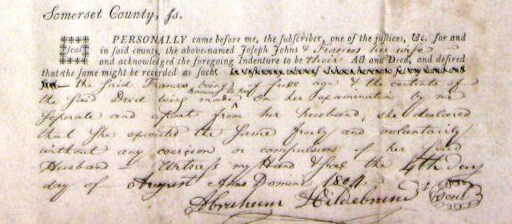
The 1777 non-associators record meant Judge Hildebrand was not in the Revolutionary War and chose to be non-associated due to his religious beliefs as a Dunkard – a Peace church.
It is believed that Johannas Hildebrand may have been the father of Abraham Hildebrand. Johan, before the age of sixteen, arrived in Philadelphia, Pennsylvania on September 24 1734 on the ship St. Andrew. He was discovered as a stowaway passenger. He had apparently run away from home to follow his older brothers to the Americas, which is why he was listed on the Ship’s manifest as cargo. After being discovered he was forced to work on the ship as an indentured passenger to pay for his fare and was released with his brothers upon arriving in Philadelphia
John Dewatt Weimer (1740-1831) My 5th great-grandfather, my 4th great grandfather on my grandfather Clifford’s mother’s side.
John and his brothers Martin and Frederick immigrated to America from Germany in the 1760’s.
He served as a corporal in Captain John Riley’s Co., Third Pennsylvania Continental Line in 1778-79 which was at Valley Forge with George Washington. He was twice listed as having “Insufficient clothing” at Valley Forge. His name is sometimes recorded as Wimmer, Wymer or Wemmer..
After the Revolution, John, his wife Susanna Ackerman, and their family settled in Somerset County where he was granted 336 acres of bounty land in Milford Township. He received title to his land on Feb. 26, 1788 and named it “Prospect Hill.”

Hackler & Delp, (Hechler & Delph) On my grandma Clifford’s paternal side.
Johann Georg Hechler (1743-1821) arrived at age 11 with his parents, Hans Georg Hechler (originally from Alsace) and Susanna Müller, in Pennsylvania in 1754. They lived in Manchester Township in York County, Pennsylvania and were members of Quickel’s Lutheran Reformed Church. He married Elizabeth Peter in 1770 and moved to Elk Creek, Grayson County, Virginia in the Blue Ridge Mountains, sometime in the early 1780’s.
His son Peter Hackler was married to Mackalana “Molly” Delp, daughter of Peter Delp and Eveline Reichbacher. Peter Delp’s parents were Hans Georg Delp and Barbara Moyer. Hans Georg Delp (1708-1773) immigrated to Pennsylvania in 1738 and settled in Montgomery County. Although many genealogies list Peter Hackler as being born in Grayson County, Virginia, it is unlikely since his parents stayed in Pennsylvania.
Not much else is known about these families, except that they were very prolific. I have confirmed my mom having 396 DNA matches with Delp shared ancestors and 213 matches with Hackler shared ancestors. The Delps are second only to the Cornetts. Some matches are descended from Cornetts, Hacklers AND Delps, with some who also descend from Russells and Stampers, too! …Many descend from both due to siblings of one family marrying siblings of the other family.
The Baughers– Johannius Georgius Bager (1725-1791), my 6th great grandfather, on my grandma Clifford’s maternal side.
It appears that most, if not all, Baughers in the United States are descendants of Johannius Georgius Bager and Anna Elizabeth Schwab. They were married in Giessen, Darmstadt, Germany in 1748 and sailed to America on a ship called the “Rawley” in 1752. The “u” and “h” were added to the Bager name upon arrival in North America (Many various pronunciations of Baugher are found among descendants.) Johannius Georgius Bager was educated at the University of Halle (This is the same university that my famous ancestor Barthold Heinrich Brockes on my dad’s side went almost 50 years earlier.) Bager was ordained and installed at Simmern, Germany, in the month of December 1749. He was sent to be a pastor of the Lutherans in Pennsylvania, December 16th, 1752. Shortly after arriving to America with his wife and son, he became the pastor of St. Michael’s, an old log church along the Carlisle Pike, near Hanover, PA. He made many ministry tours helping to establish more than one hundred churches in Baltimore, Maryland, and several Pennsylvania Counties.

By identifying the DNA segments that you share with relatives with known shared ancestors, you can identify segments that you likely inherited from those shared ancestral couples, using the online DNA tool, DNA Painter.
(In some cases, my known relatives were descendants from other marriages of an ancestor, so instead of an ancestral couple, just the one ancestor is shown as contributing that segment.)
Here is what I have been able to determine on my dad’s side:

Here is what I have been able to determine on my mom’s side. (There are several anomalies, which are likely due to multiple relationships. The most glaring one is on chromosome 18 which has overlaps of relatives on both my grandfather’s Verbryck/Holt side and my grandmother’s Cornett/Pennington/Stamper sides. I believe that perhaps that the Holt and Pennington sides might be related somehow. They both have roots in Virginia…There are a lot of double+ relationships with DNA matches on my grandmother’s Cornett side of the family back in early Virginia and North Carolina! )


I thought it might be interesting to look at other surnames in my tree and try to find likely relatives in other surname projects at ftDNA. There are also a few basic Y-DNA haplogroups for some of my matches at 23 and Me.
To recap what I have determined or postulate on my dad’s Kelley/Kelly side:



On my Grandpa Clifford’s side:



On Grandma Clifford’s Cornett side:
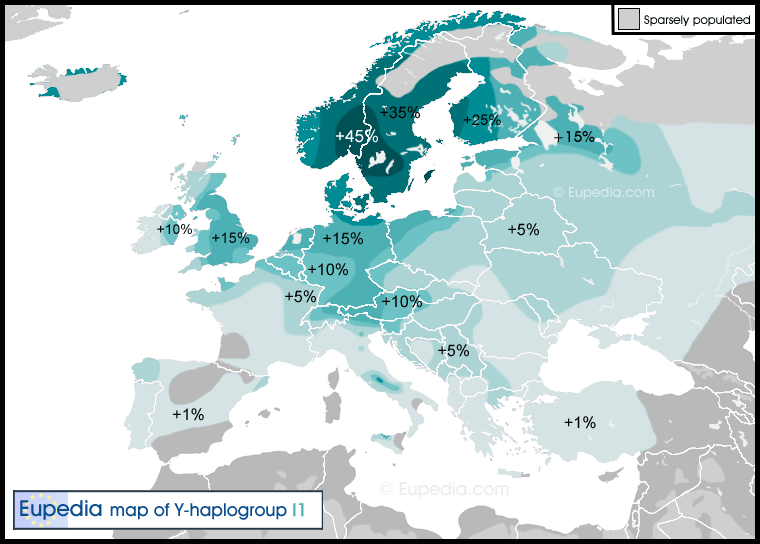

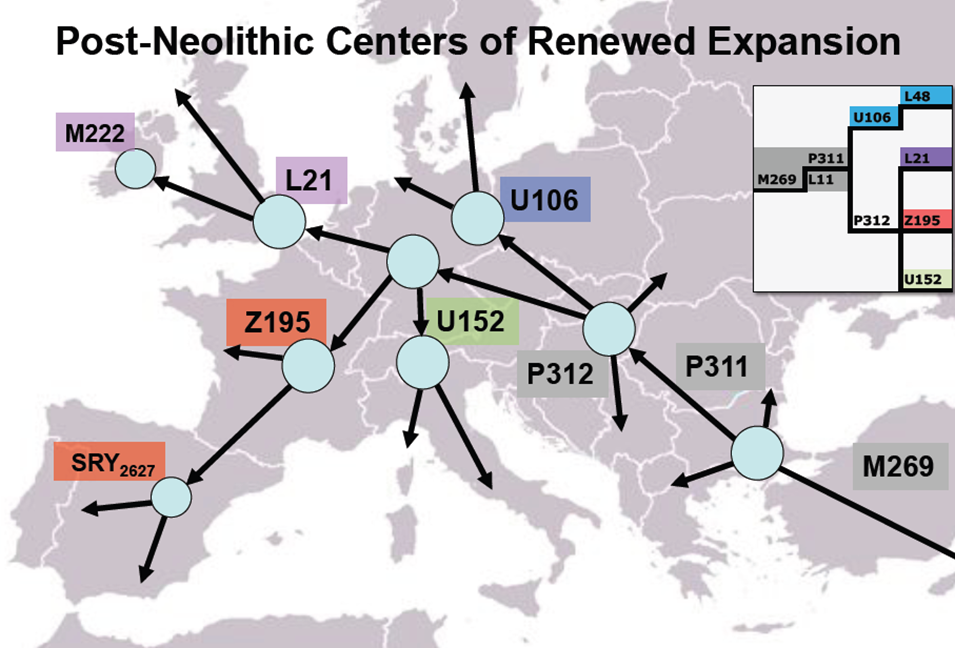

Womens’ occupations were usually listed as “None,” “at home” or “Keeping House” on census records. I include them only if another occupation is known for them other than homemaking —Homemaking usually included child-rearing, housework, food production & preservation, etc.—still important occupations!
For the men and some of the women, I will list their primary occupation(s) first and then other jobs they may have had.
PARENTS




Army (promoted to Sergeant Major) in the Korean War.


GRANDPARENTS


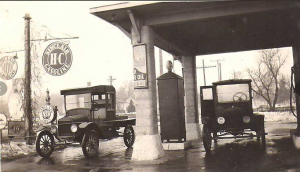


 Woodworker/Cabinet Maker. Hallack & Howard Planing Mill, Angelus Furniture & Self-employed. (Learned his trade at Uhrich Revolving Door Factory.)
Woodworker/Cabinet Maker. Hallack & Howard Planing Mill, Angelus Furniture & Self-employed. (Learned his trade at Uhrich Revolving Door Factory.)



GREAT-GRANDPARENTS

Carpenter.



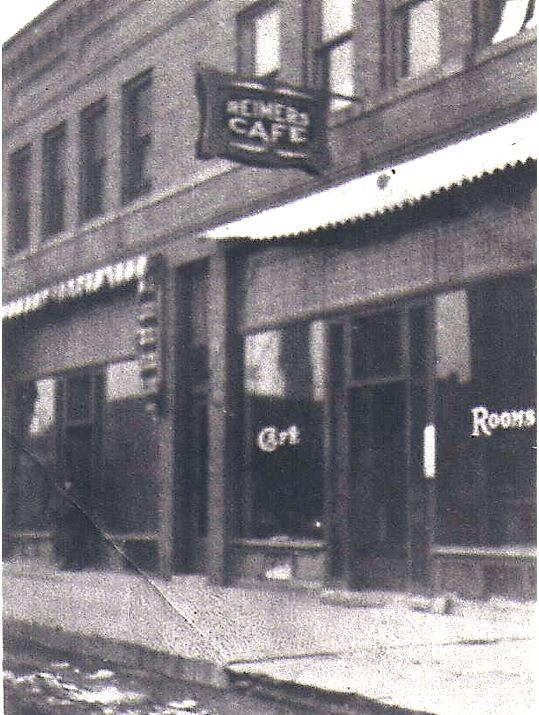

Farmer.

 John M. Cornett (working from bef. 1900- 1940)
John M. Cornett (working from bef. 1900- 1940)2nd GREAT-GRANDPARENTS








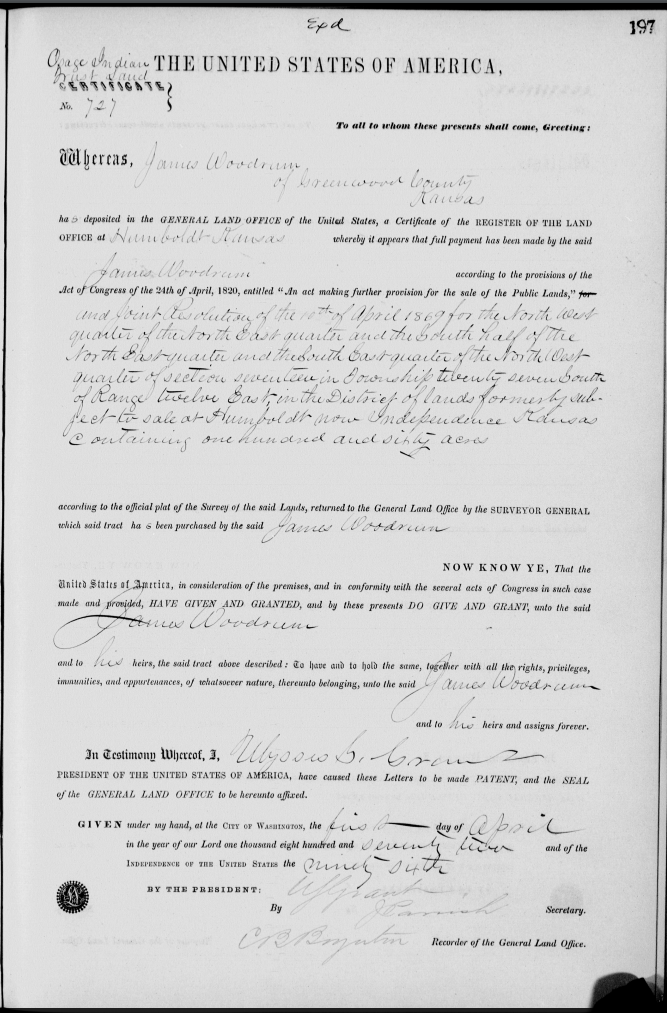
3rd GREAT-GRANDPARENTS
Andrew Kelly
Jan Hinderks Auen
Meine Gerds DeBuhr
Claus Hansen Reimers
Johann Jacob Arps
Johann Peter Brockes
Eggert Sammann
Thomas Clifford
Robert Irwin
William Verbryck
James Hildebrand
Alfred Alexander Cornutt
Ephriam William Stamper
Archibald Woodrum
Sarah Johnston Woodrum
John Baugher
We get 50% of our nuclear DNA from each of our parents. But because of how chromosomes recombine and divide during meiosis, the contribution that we get from our grandparents can vary, even though the PROBABILITY is 25%. Therefore, each generation of more distant ancestors may contribute varying amounts to our genome.
What we know about Ed’s ancestry:
Edmund Bressette, Sr:
Tracing back his tree, Ed Sr. is all French Canadian. I have only found one German amongst all the French. I have not been able to verify the family lore of any Iroquois, or other Native American in either the tree or the DNA analysis.—
This is also confirmed with his, and Ed Jr’s inclusion in the French Settlers Along the St. Lawrence Genetic Community:
Overview: “Many French settlers of the St. Lawrence Valley came to present-day Québec, Canada, to work in the fur trade. They lived in a harsh climate surrounded by dangerous wilderness and hostile native tribes. Life became even more challenging after the French and Indian War when the British assumed control and classified French Canadians as second-class citizens. While some left for New England and industrialized cities like Chicago, Minneapolis, and Detroit, those who remained created a strong community centered around Catholicism and their French heritage.”
Here is the new ethnicity estimate for Ed Sr.:

It is pretty much as would be expected. It is likely that many of his ancestors were from Normandy which could account for the 10% England, Wales, Northwestern Europe.
Pam Scott Bressette:
Pam’s mother, Malvina Schumacher Scott, is mostly all ethnic German. Her ancestors settled in North & South Dakota after living a couple of generations in “Little Russia” or the Odessa region in the Ukraine. Most were originally from Alsace, some from other parts of Germany.
This is also confirmed with Pam and Ed Jr’s inclusion in the Germans from Alsace-Lorraine in North Dakota Genetic Community:
Overview: “German-speaking immigrants first came to America for familiar reasons: land, economic opportunity, and religious freedom. Ongoing revolutions in Germany prompted many more to follow. In America they were known as excellent farmers whose hard work and unique culture transformed the American Midwest, which even today has the highest proportion of German ancestry in America. However, despite their contributions, they faced prejudice and discrimination during World War I and World War II.”
The biggest puzzle has been Pam’s father’s, Oren Scott’s ancestry. Since he was adopted, It has taken a lot of research to determine his ancestry.
I have confirmed that his biological mother was Mildred Kathleen Bearns (1905-?). She was born in South Africa, the daughter of a prospector originally from St. John’s, Newfoundland. Her ancestry appears to be mostly English & Irish.
I have also determined that the man, Mildred Bearns married was not the father of her baby. (Oren was born less than 5 months after she married.) I am now pretty sure his biological father was a Canadian trucker by the name of Carlton Lundy, the only son of Alice Rand (1904-?). Pam has a lot of DNA cousin matches with the Rand family. The Rand family originated in New England, mostly Maine & Rhode Island. The Lundy family traces back through Manitoba & Ontario, back to New Jersey, Pennsylvania, New York, & Connecticut with some French & Scottish lines. Pam has some distant cousin matches related to this line—I am waiting to get some closer matches before I am absolutely certain of this relationship.
Both of these lines on her father’s side are likely where Pam gets her connection to the Settlers of Colonial New England Genetic Community:
Overview: “Long a haven for English colonists, the rocky coast of New England welcomed newcomers from the Palatinate region of Germany and Scots-Irish from northern Ireland in the 1700s. After the French and Indian War, the British increased taxes on the colonists and tensions began to rise. Boston became the center of the revolutionary spirit until the American colonies won their independence. Eventually mills and manufacturing overshadowed farming, and Boston and New York became crucial international ports and centers of American literature, culture, and the arts.”
Here is Pam’s new ethnicity estimate:

I would have expected more German than what is predicted here. It should be closer to 50%, but the Northwestern Europe category appears to include Alsace, barely, and some of Germany. It is likely that some or most of the Scandinavian is from her mother’s side, too.
I expected at least 14% Ireland & Scotland from her dad’s side, with most of the rest (~32-36%) being English. So it appears that Pam may have received 1/2 of her England, Wales & Northwestern Europe from each of her parents.
Here is Ed Jr’s New Ethnicity Estimate:

Comparing Ed Jr’s actual estimate with his (predicted) estimate using his parents’ estimates I get the following:
So it is pretty close, except from whence did the 1% Sardinia come? I would guess mostly from his dad’s side, but in order for it to show up in Ed Jr. and not in Ed Sr., he might have got some from his mom’s side, too!
Here is Edmund Jr.’s results compared with his son, Sky’s:

If I compare what Sky’s actual results are with what would be (expected) from averaging his dad’s and mine, I get the following:
He appears to have inherited much more of the English than any of the other ethnicities. He didn’t get much of the French, German or Irish! Looking at the following chart, it looks like he got about 7.5% more DNA from his Grandma B than his Grandpa B.
Here is a comparison of DNA shared amongst the Bressettes and the Scotts: (Percentages on the bottom left half of the matrix and the actual centimorgans shared across/# of segments on the top right.)
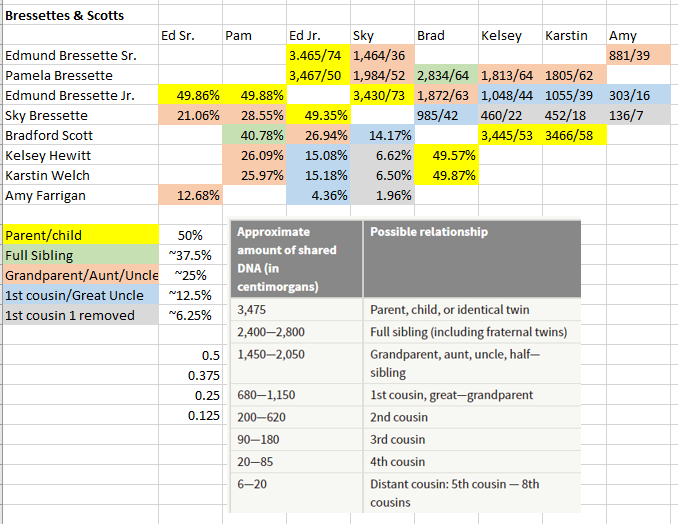
The biggest anomaly here is that Amy Farrigan, (Ed’s Sr’s niece and Ed Jr’s cousin appear to share half the DNA than would be expected. (Lisa shared Brad’s results with me, but I don’t have Karstin & Kelsey’s, so I can’t compare them to each other. It also takes a manager to update to new ethnicity estimates, Brad and his girls haven’t done so— I can’t compare apples to apples!)
Old Analyses:
DNA Ethnicity comparisons of Ed’s family
These percentages from DNA results are only estimates, median values of a range of possibilities. The width of the range depends on how heterogeneous or homogeneous that ethnic group is.
It is important to note how they come up with these estimates. They compare our DNA to a sample group of individuals from each region. It sometimes becomes difficult to distinguish distinct ethnic groups, depending on how much interbreeding occurred between groups. Those living close to trade routes or coastlines subject to invasion are likely to be genetically diverse than those who were more isolated.
Since Ed Sr. came up with a lot of Great Britain and no Europe West, it seems likely that much of his French were Norman.
According to my Ethnicity Estimate on my DNA test, I am about 25% Irish. We know my Great-Grandfather, Andrew Kelley, and his father Michael Kelly, immigrated from Ireland around 1867. What is surprising, however, is that my mom showed up as 35% Irish.
On my mom’s side we know for sure my 3rd great-grandmother, Catherine Lawson Clifford was born in Donegal, Ireland. (She would account for about 6 1/4% of mom’s Irish.)
Her father, James Lawson, also born in Donegal, Ireland, was thought to have been the Captain of a merchant ship (Grace) which is said to have figured prominently in numerous sea battles during the American Revolution. “The ship Grace was later purchased by the Fleming family (relationship to [his wife] Sarah Fleming Lawson unknown.)”
He brought his wife and 11 children to the United States sometime around 1795, and settled in Fairfield Township, in Westmoreland County Pennsylvania. His daughter Catherine, was married to Thomas Clifford.
One source states:” James Barbour Lawson, came to America about 1775 from County Donegal, Ireland. The family name apparently was originally McLaren, but family tradition has always said the Lawsons were not originally from Ireland or Scotland, but from the Isle of Man…”
My 4th Great-grandfather, Edward Irwin, might also have come from Ireland. (That would account for another 3 1/8 % of mom’s Irish).
My Dad’s Grandfather, Andrew Alfred Kelley, was born in Kinnitty, Kings County (now Offaly), Ireland. He probably mostly grew up in Beigh/Beagh in Limerick, County. He was a poet and often wrote reminiscing about his native Ireland:
 His father, Michael Britt Kelly, was born in Bruff, Limerick County, Ireland. He was a schoolteacher and sometimes worked as a “Visiting Tutor.” He was knowledgeable in Latin and Greek, as is evident from writings in his bible. He also was aware of his Kelly heritage. There is a hand drawn sketch of a tower with the Kelly motto below: “Turris fortis mihi deus,” “God is my Tower of Strength.”
His father, Michael Britt Kelly, was born in Bruff, Limerick County, Ireland. He was a schoolteacher and sometimes worked as a “Visiting Tutor.” He was knowledgeable in Latin and Greek, as is evident from writings in his bible. He also was aware of his Kelly heritage. There is a hand drawn sketch of a tower with the Kelly motto below: “Turris fortis mihi deus,” “God is my Tower of Strength.”
Here is the Parochial schoolhouse where he taught in Beigh, Limerick County in 1847:
From Ancestry.com: “North American form of French Bresset, from a pet form of the personal name Brès, a variant of Brice,” in other words ‘Little Brice.’ Maybe from the 5th Century French Bishop of Tours, Saint Brice.
The Bressettes were early settlers in French Canada. The earliest ancestor I have found was Jean Baptiste Brissett (1793-?). Generations of the family moved back and forth between Quebec and New York State. Most worked in textile mills.
The name has been found variously spelled. In fact, my father-in-law said he had to legally correct his original birth certificate because of a misspelling. I have found the name spelled (or transcribed in indexes) the following ways: Bressette, Bresette, Bresett, Brissette, Brisset, Besset & Briessette